You’ll find that modern wearable touchscreens work effectively in rain thanks to hydrophobic coatings that repel water droplets and specialized capacitive technology. RainCheck technology improves touch accuracy by nearly 48% in wet conditions, while projected capacitance sensors differentiate between your finger and raindrops using high-frequency operations. Leading devices from Garmin, Samsung, and Apple feature IP66-IP67 waterproof ratings with thermoplastic polyurethane materials and precision sealing. Advanced algorithms and emerging AI-enhanced interfaces guarantee your device responds accurately even during downpours.
Technology Options for Rain-Resistant Wearable Displays
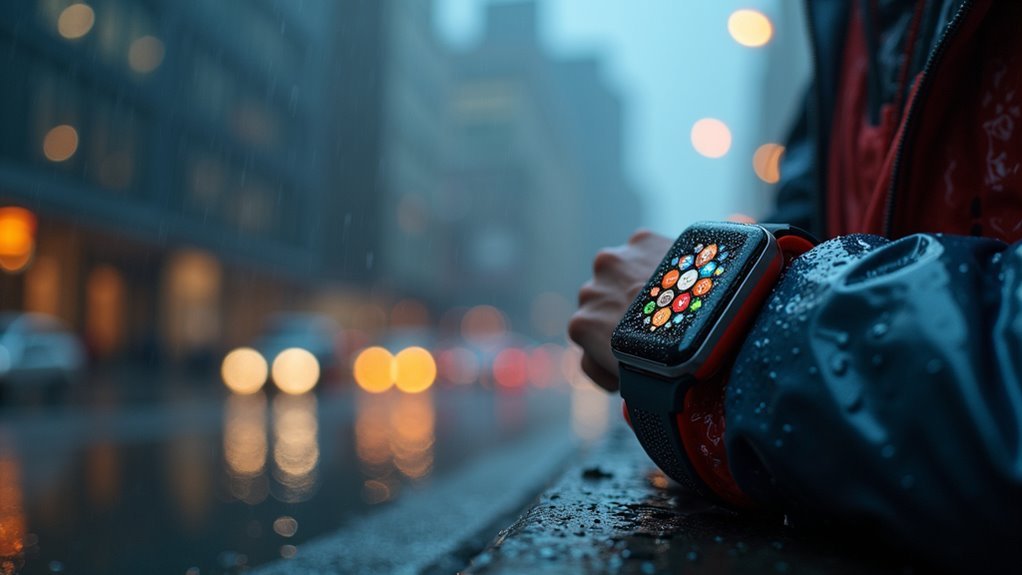
When designing wearable touchscreens for rainy conditions, you’ll encounter several proven technology approaches that protect displays while maintaining touch functionality.
Hydrophobic coatings represent your first line of defense, repelling water droplets from touchscreen surfaces to improve usability during wet weather. You can implement specialized waterproof membranes and nano-coatings that prevent water penetration into display electronics without compromising touch sensitivity.
Transparent waterproof layers preserve display clarity and brightness while delivering essential water resistance.
You’ll also benefit from combining durable elastomeric materials with waterproof films to shield sensitive screen components from direct rain exposure. Modern wearables often incorporate plastic housings that provide additional structural protection against moisture infiltration.
These coating technologies guarantee your wearables continue functioning reliably outdoors during rain or high humidity, maintaining both performance and user experience.
Enhanced Touch Sensitivity in Wet Conditions
While traditional capacitive touchscreens struggle with water interference, advanced sensing technologies now enable your wearable displays to maintain remarkable touch accuracy even during heavy rainfall.
RainCheck technology exemplifies this progress, improving touch accuracy by 47.9% and gesture accuracy by 75.7% in wet conditions by filtering water interference through low-level sensor data analysis.
RainCheck technology delivers impressive performance gains, boosting touch accuracy by 47.9% and gesture recognition by 75.7% in challenging wet conditions.
Your device achieves this through projected capacitance technology combined with water-tolerant controllers and advanced signal processing algorithms.
These systems differentiate between actual finger touches and water droplets using high-frequency operations and strategic sensor placement.
Water-resistant coatings and optimized electrode designs further minimize interference, while sophisticated calibration algorithms guarantee consistent performance in humid environments, delivering reliable touch responsiveness regardless of weather conditions. Temperature sensors can monitor environmental conditions to help maintain optimal touchscreen performance across varying weather patterns.
Waterproofing Methods and Material Selection
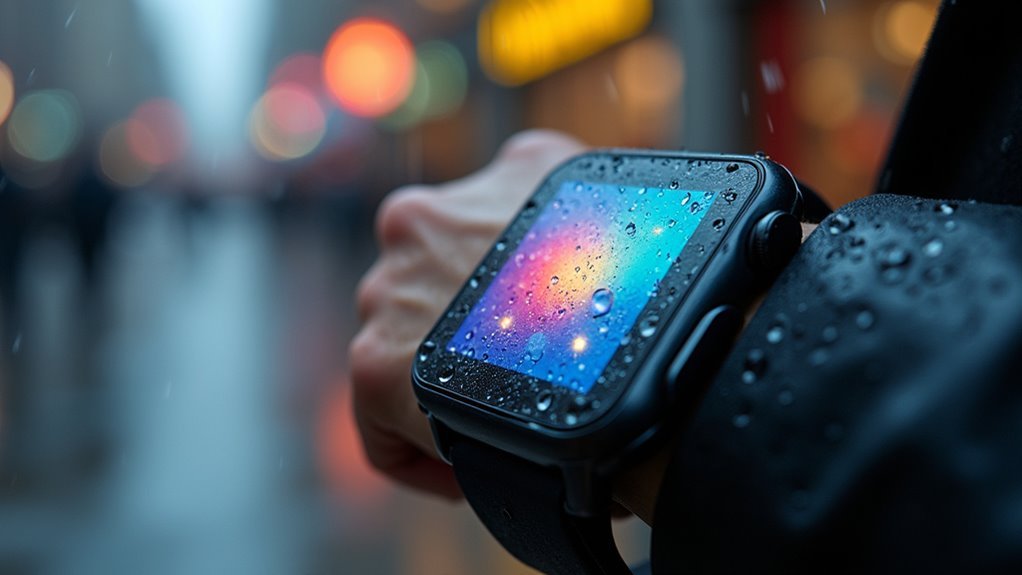
Beyond sophisticated touch sensing algorithms, effective waterproofing in your wearable touchscreen depends on carefully selected materials and proven sealing methods.
Thermoplastic Polyurethane (TPU) serves as your primary defense, offering flexibility and moisture resistance while maintaining device ergonomics. You’ll find TPU used in layered structures that create protective barriers over circuitry without compromising functionality.
Specialized hydrophobic coatings repel water while preserving touch sensitivity and screen clarity. These nano-formulations maintain anti-fingerprint properties and light transmission.
Your device’s assembly requires precision sealing around frames and interfaces using waterproof adhesives and engineered tapes. Hot-melt adhesives create hermetic seals, while conformal coatings encapsulate sensitive electronics.
For maximum protection, detachable components like external battery packs can be removed during exposure to harsh conditions, preventing damage to sensitive charging interfaces while maintaining core device functionality.
IP ratings like IP66 and IP67 validate your device’s waterproof performance through rigorous testing protocols.
Applications in Fitness and Outdoor Sports Devices
When you’re pushing through a downpour during your morning run, your fitness tracker’s touchscreen needs to respond just as reliably as it does on sunny days.
You’ll find that modern smartwatches undergo rigorous weather durability testing to guarantee their displays maintain functionality when rain hits the screen.
Your outdoor GPS device’s touch accuracy becomes critical when you need to quickly check your route or adjust settings while water droplets cover the interface. These waterproof capabilities have become essential features as manufacturers respond to increasing consumer demand for reliable performance in all weather conditions.
Fitness Tracker Rain Performance
As outdoor fitness enthusiasts push their limits regardless of weather conditions, modern fitness trackers have evolved to deliver reliable touchscreen performance even during heavy rainfall. You’ll find that today’s devices incorporate water rejection algorithms and enhanced sensitivity settings that differentiate between raindrops and intentional touch inputs.
| Device Feature | Rain Performance Benefit |
|---|---|
| 5ATM Water Rating | Protects against heavy rain and water splashes |
| Nano-coatings | Maintains responsiveness when screen gets wet |
| Dynamic Sensitivity | Adapts to wet finger touches automatically |
| Wide-angle OLED | Guarantees visibility during stormy conditions |
Your fitness tracker continues monitoring heart rate, steps, and stress levels without interruption. Whether you’re running through downpours or cycling in drizzle, these waterproof devices guarantee accurate data collection while providing reliable touchscreen control throughout your workout. Premium models often include 6-month memberships to fitness platforms that help you analyze your rain-weather training data and optimize performance across different weather conditions.
Smartwatch Weather Durability Testing
Professional smartwatch manufacturers put their devices through rigorous standardized testing protocols to guarantee they can withstand the demanding conditions faced by fitness enthusiasts and outdoor athletes.
You’ll find devices tested under ASTM G155 and ISO 4892-2 standards, which expose materials to UV light, water spray, and temperature variations to assess photostability and colorfastness.
Water resistance testing verifies your smartwatch functions while submerged during swimming or water sports.
Impact tests simulate real-world drops you might experience during activities. Temperature and humidity variations test reliability across diverse outdoor conditions, while environmental simulations replicate rain, snow, and extreme temperatures.
Functional testing confirms that heart rate monitoring and GPS tracking operate correctly regardless of weather conditions, assuring you can depend on your device’s performance. These comprehensive tests are essential given that quarter shipments of wearable electronics exceeded 100 million in Q1 2021, reflecting the massive market demand for reliable devices.
Outdoor GPS Touch Accuracy
While your smartwatch might excel at weather resistance testing, the real-world performance of GPS accuracy becomes critical when you’re maneuvering through challenging terrain or tracking fitness metrics in remote locations. Modern outdoor GPS devices achieve horizontal accuracy of less than 6 feet through multi-GNSS support, combining GPS, GLONASS, GALILEO, and other satellite systems.
| Feature | Benefit | Performance |
|---|---|---|
| Multi-Band GNSS | Enhanced signal reception | Sub-6 foot accuracy |
| Route Tracking | Real-time fitness monitoring | Precise distance/pace data |
| Emergency Features | Safety in remote areas | SOS alerts/location sharing |
You’ll find devices like the Garmin GPSMAP series maintain 4.5-star accuracy ratings while providing thorough workout monitoring, geofencing capabilities, and seamless app integration for analyzing your performance data across multiple outdoor sports activities. These units deliver reliable performance even in challenging conditions like dense foliage, urban canyons, and steep terrain where other GPS devices might experience significant tracking errors.
Development Challenges and Testing Standards
When you’re designing wearable touchscreens for wet conditions, you’ll face complex decisions about selecting materials that balance flexibility, conductivity, and transparency while maintaining durability.
You’ll need to implement sophisticated sealing technologies like IP67/68 standards to prevent water ingress without compromising the device’s responsiveness or thickness. Power consumption management becomes critical since video displays require significant energy, and wet conditions may limit charging opportunities when wireless charging generates additional heat during operation.
You’ll also discover that rigorous testing protocols must simulate real-world conditions including rain exposure, underwater submersion, and temperature variations to guarantee your device performs reliably when users need it most.
Material Selection Complexities
Beyond the fundamental engineering hurdles, manufacturers face intricate material selection decisions that determine whether rain-resistant wearable touchscreens will thrive or fail in real-world conditions.
You’ll need thick, toughened glass that resists scratches while maintaining capacitive sensitivity. Chemical robustness becomes critical when your device encounters cleaning agents or industrial contaminants that can degrade protective coatings.
Corrosion resistance matters especially in coastal environments where salt spray attacks metal components. Your materials must withstand extreme temperature fluctuations without warping or delamination.
Testing protocols verify humidity tolerance, ensuring touchscreens won’t generate false inputs under condensation. UV stability prevents color degradation during prolonged sunlight exposure.
You’re balancing durability against repairability—some ceramics offer superior protection but can’t be fixed if cracked, affecting long-term ownership costs. Proper IP ratings ensure moisture ingress protection and long-term reliability in wet conditions.
Sealing Technology Requirements
Since water will find even microscopic gaps in your wearable’s construction, you’ll need sophisticated sealing technology that creates an impenetrable barrier around the touchscreen perimeter. Your sealing solution must exceed minimum thickness requirements—like .125″ of 3M 200MP for IP67 rating—while withstanding temperature fluctuations, impacts, and repeated flexing without compromising protection.
The most critical sealing requirements include:
- Multi-layer gasket assembly with overmolded elastomers creating chemical bonds between materials
- Pressure-resistant perimeter seals that maintain integrity during submersion and environmental stress
- Lightweight, flexible construction that won’t add bulk or cause discomfort during prolonged wear
Your sealing design must pass rigorous IP67/IP68 compliance testing, including controlled water exposure at various angles and pressures, ensuring reliable performance throughout your device’s lifecycle. The overmolding process also provides additional benefits like vibration dampening that can improve touchscreen responsiveness in harsh working conditions.
Rigorous Testing Protocols
Creating a rain-resistant wearable touchscreen that meets industry standards requires subjecting your device to an extensive battery of tests that push every component to its limits.
You’ll need to achieve IPX7 certification through temporary water immersion up to one meter for thirty minutes, while IP67/68 testing evaluates deeper, prolonged submersion.
Your touchscreen must maintain responsiveness during simulated rain conditions and water jet exposure from IPX4-6K protocols.
Material selection becomes critical as you balance water resistance with touch sensitivity.
You’ll face design complexities protecting sensors and electronics while preserving user experience.
Specialized testing equipment like immersion tanks and spray chambers validate performance.
UL Solutions and TÜV SÜD certification guarantee global compliance, requiring rigorous documentation and quality control measures throughout your development process.
Beyond water resistance, your wearable must pass EMC testing to ensure electromagnetic compatibility for market entry across all global regions.
Market Leaders and Emerging Solutions
While traditional touchscreen manufacturers scramble to adapt their technologies for wet conditions, several market leaders have already established themselves as pioneers in rain-resistant wearable displays.
You’ll find companies like Garmin and Samsung leading the charge with proven water-resistant capabilities, while Apple’s Watch Ultra 2 sets premium standards for durability.
Emerging solutions are reshaping what’s possible:
- AI-enhanced interfaces that adapt touch sensitivity based on environmental conditions and moisture detection
- Gesture recognition technology that reduces your reliance on direct touch when screens are wet
- Advanced materials integration using luxury-grade components for superior water resistance
Brands like Amazfit and Ultrahuman are pushing boundaries with innovative health monitoring features that maintain functionality regardless of weather conditions. The Apple Watch Series 10 features integrated water temperature sensors that activate automatically when the device detects water contact.
Frequently Asked Questions
How Much Do Waterproof Wearable Touchscreens Typically Cost Compared to Regular Ones?
You’ll pay $200-$400 more for waterproof touchscreen wearables compared to regular ones. While standard models cost $100-$400, waterproof versions typically range from $400-$800 due to specialized sealing technology.
What Is the Average Battery Life Impact of Rain-Resistant Touchscreen Technology?
You’ll experience a 10-15% battery life reduction with rain-resistant touchscreen technology. The increased power consumption comes from waterproof coatings and advanced algorithms, though newer efficient technologies minimize this impact considerably.
Can Existing Non-Waterproof Wearable Devices Be Retrofitted With Rain-Resistant Touchscreens?
You can retrofit some non-waterproof wearables with advanced touch controllers and protective coatings, but it’s expensive and requires technical expertise. Many devices need complete redesigns rather than simple upgrades.
How Do You Properly Clean and Maintain Waterproof Touchscreens After Rain Exposure?
After rain exposure, you’ll want to power off your device first. Gently wipe the waterproof touchscreen using a damp microfiber cloth in circular motions, then dry completely with another cloth.
Are There Any Health Concerns From Wearing Waterproof Touchscreen Devices Long-Term?
You’ll face potential skin irritation from waterproof coatings, increased fungal infection risk from trapped moisture, and possible allergic reactions. You should also consider electromagnetic exposure effects and guarantee you’re maintaining proper hygiene practices.
In Summary
You’ll find that rain-resistant wearable touchscreens aren’t just a luxury anymore—they’re becoming essential for active lifestyles. Whether you’re tracking your morning run or steering through hiking trails, these devices won’t let water interfere with functionality. As manufacturers continue refining waterproofing technologies and touch sensitivity algorithms, you can expect more reliable outdoor wearables. The technology’s rapidly advancing, making weather-proof interaction a standard feature you’ll soon take for granted in all wearable devices.

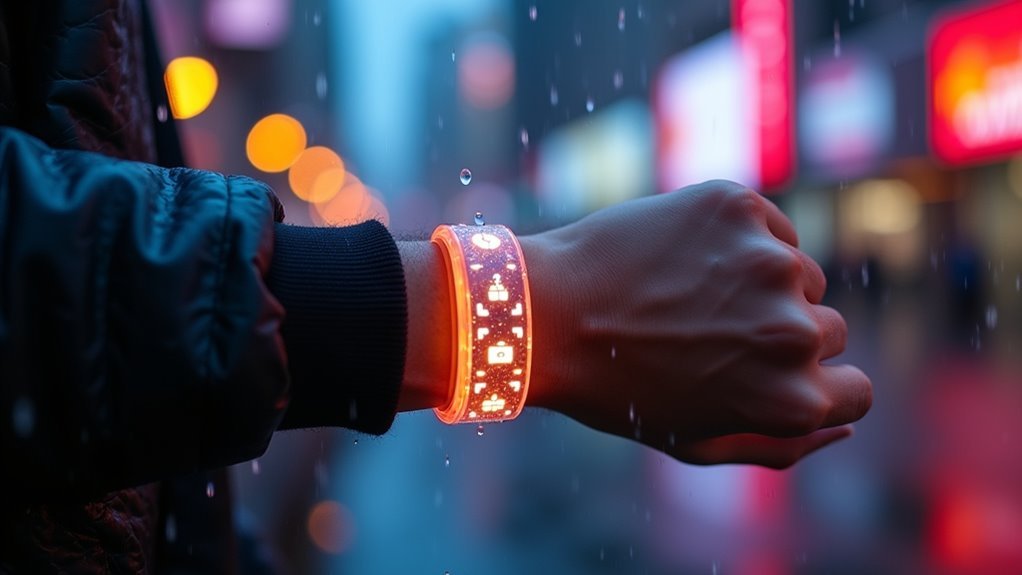
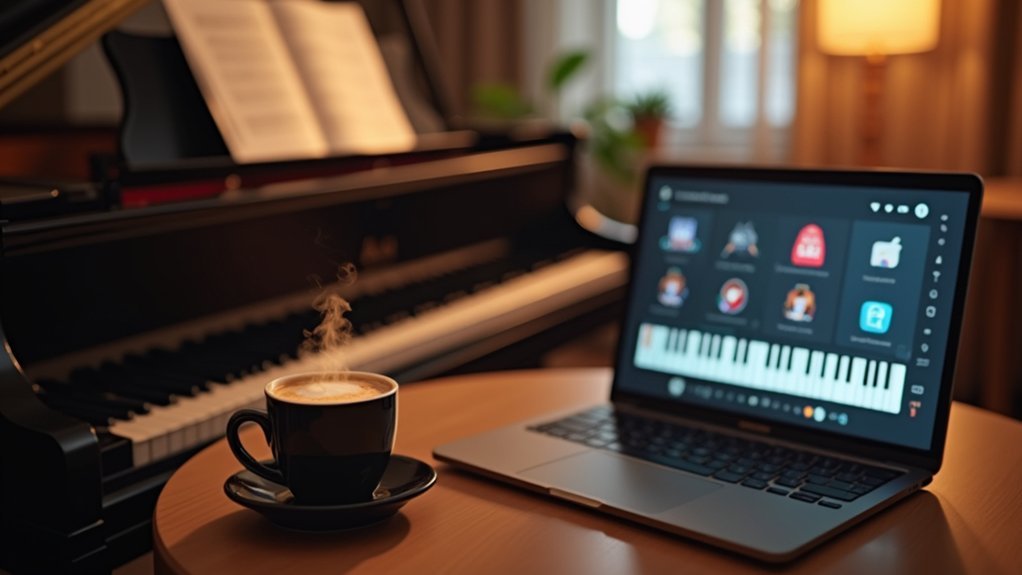
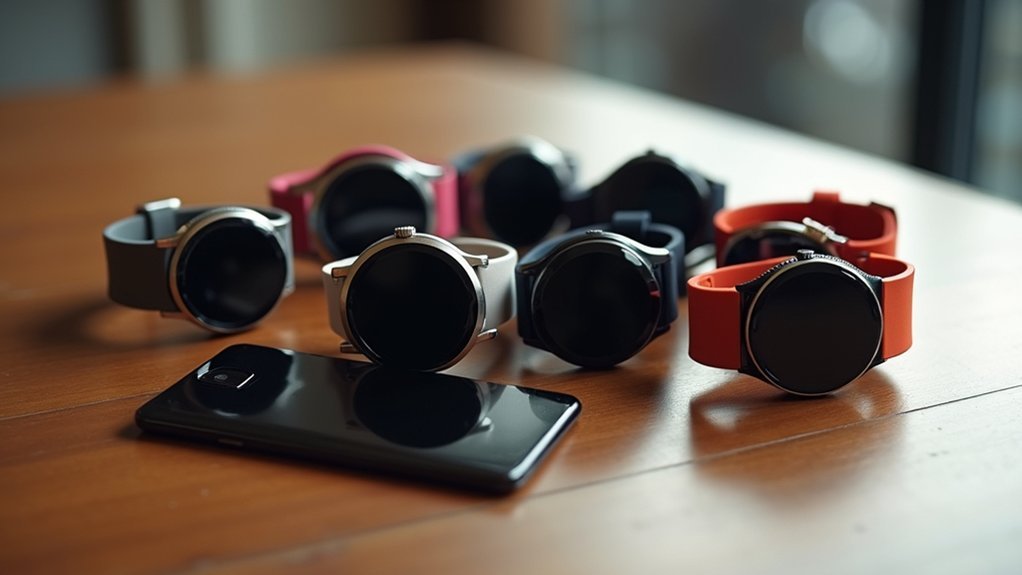
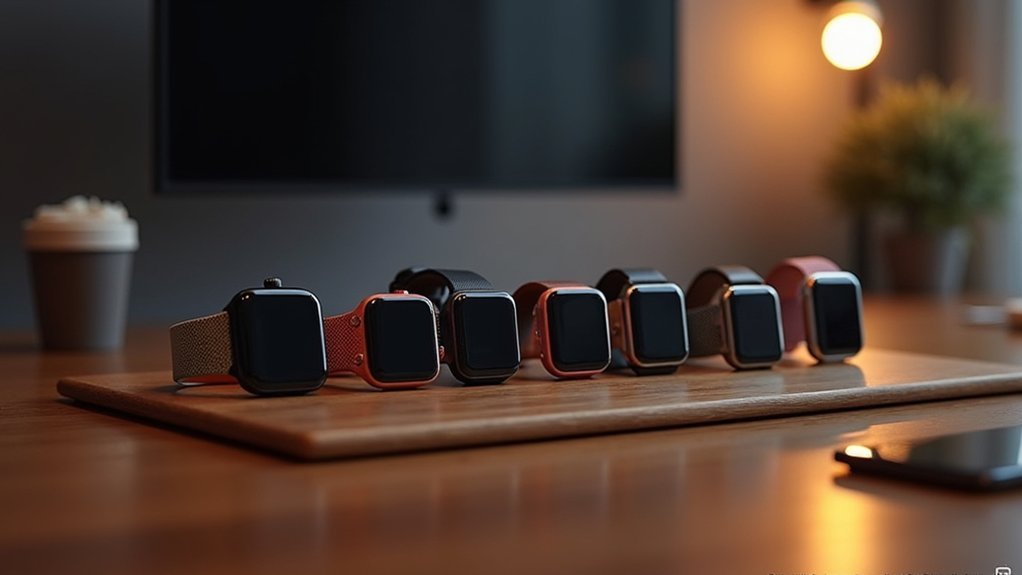
Leave a Reply